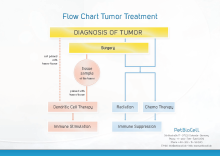PetBioCell - Biohazard in Tumor Treatments
Dear collueagues,
this PetBioCell Newsletter presents two recent published articles in veterinary journals which discuss the question of the degradation /excretion route of chemotherapeutics after the treatment of tumor patients and the occurring biohazard for the practice team and members of the patients’ family.
Especially the dedicated staff of the veterinary team is often confronted with this important topic of the threat resulting from the chemotherapeutic treatment agents, procedures and materials.
In AAHA’s Trends magazine of June 2015, Douglas H. Thamm DVM gives in his article titled „Stay safe while saving life“ 10 top tips to bring the „As Low as reasonable achievable“ (ALARA) principle into the minds of the practice team. His advices include suggestions to separate storage and preparation of chemotherapeutic drugs and other medications, personal and owner protection, dedicated waste management of used drugs and equipment, owner guidelines, knowledge of local and federal law, and last but not least the permanent staff training to avoid hazardous situations through chemotherapeutic drugs.
The excretion of residues of antineoplastic drugs used in canine sarcoma patients was evaluated by Janssens et al. (http://onlinelibrary.wiley.com/doi/10.1111/vco.12025/abstract). The extent and duration of platinum excretion was measured in dogs undergoing a 3-week-treatment-cycle of carboplatin – partly in a combination with doxorubicin or epirubicin. The authors report that urine is the major route of excretion of residual platinum substances. Even 21 days post administration, a quantifiable portion of the substances was detected. Additionally, excretion in feces and saliva is monitored, especially during the first 5 days post treatment.
Janssens et. al. conclude: „These findings may be used to further adapt current veterinary guidelines on safe handling of antineoplastic drugs and treated animals.“
For patient owners, the question of biosafety is a very big issue when they reach out to the team of PetBioCell looking for alternative tumor treatment options for their pet. We can reassure them that there is no biohazard for their family using the DC therapy.
The immunologic tumor therapy is a safe treatment method from autologous tissue (full blood and tumor tissue of the patient), a hazardous contamination of the pet, pet owner and family or the practice team is impossible because of the use of natural and autologous production components.
The following flow chart shows the three pillars of tumor treatment: immune suppressive therapies such as chemotherapy and radiation therapy and the immune enhancing dendritic cell therapy. You may use this chart to discuss therapy options with the pet owner.
http://www.petbiocell.de/en/vet/immunotherapy-dendritic-cell-therapy
Your Team of PetBioCell
Dr. Thomas Grammel
References:
Thamm DH Top 10 Tips for Safe Chemotherapy Handling in Practice, Trends Magazine June 2015, 51-53
Janssens T, et al. Inductively coupled plasma mass-spectrometric determination of platinum in excretions products of client-owned pet dogs, Vet Comp Onc, Vol 13 No 2, 124-132 (2015)

